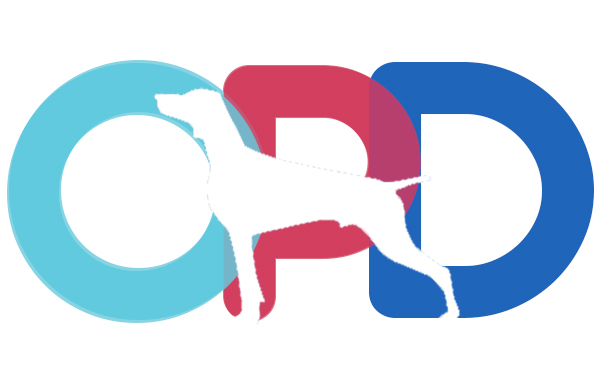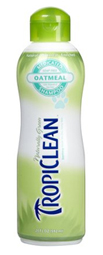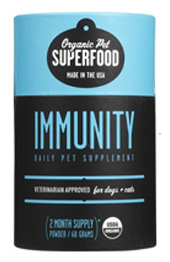This page will teach you how along with how to make a proper diagnosis:
- Dog mange symptom chart
- Cheyletiella Mange
- Demodectic Mange
- Sarcoptic Mange
Dog Mange Symptom Chart
Dog mange, which is caused by one of three microscopic mites, is an unfortunate and physically destructive disease that can take over your dog’s body if left untreated.
To figure out which type of dog mange you may have on your hands, review the following symptoms and click on the appropriate link to jump to that section…
| Mange Type | Symptoms |
|---|---|
| Cheyletiella Mange | Itching and a dusting of “dandruff” around the head, neck and back. |
| Demodectic Mange | By far the most common type of dog mange. Thinning of the hair around the eyes, mouth and front of the legs, evolving into patches approximately one inch in diameter. Skin patches may become sore, crusted and oozing. |
| Sarcoptic Mange | Digging and biting fur or skin in a ferocious manner (similar to flea infestation or severe skin rash or disease). This may in turn irritate the skin and cause oozing sores, crusty ear tips, intense itching and loss of hair, mainly on the ears, elbows, legs and face. |
| Still not sure what type of mange your dog has or if they even have it? | Submit a picture to our veterinarians via My Online Vet, and be sure to include your dog’s history and information including: breed, age, diet, previous issues, attempted treatments and outcomes and previous vet advice. |
How to Treat Dog Mange:
Cheyletiella Mange
Of the three types of dog mange, Cheyletiella Mange is the least serious and has the mildest effects.
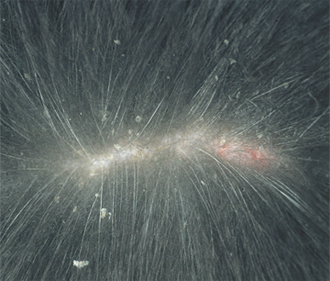
Also known as “walking dandruff”, it mainly affects puppies and is caused by a large red mite that can be seen under an magnifying glass (unlike some other mites, at least you can identify this bad bug!).
Walking dandruff is short-lived and the mite dies very soon after being removed from the host’s body.
Cheyletiella Mange Symptoms
Cheyletiella mange can cause mild itching and a dusting of dandruff around the head, neck and back.
And this mite is a very talented jumper! Watch out… though this mange is relatively harmless, it is highly contagious to other dogs and humans.
How to Treat Dog Mange: Cheyletiella Mange
As mentioned above, this type of mange is short-lived. It will usually run its course and and die in about 3 weeks.
Bathing your dog with a mild, organic shampoo such as Tropiclean Oatmeal Shampoo should help. You can also search your dog for these red mites and remove them in the bath just like you would with a case of fleas.
How to Treat Dog Mange:
Demodectic Mange
Without knowing it, Demodectic mange is probably what you had in mind when you began researching how to treat dog mange as it is by far the most common type.
Unlike Cheyletiella Mange, Demodectic mange is not contagious to dogs or humans. It is caused by a minuscule mite, demodexcanis, that can’t even be seen with a magnifying glass.
This particular mite is actually present in the pores of all puppies, ages 3-12 months as well as some adult dogs.
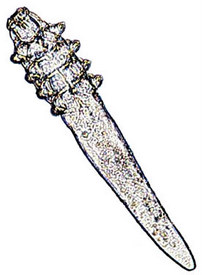
Would you believe us if we told you that these tiny mites can also be found on peoples’ faces? It’s true… they are commonly found around the eyebrows and noses of humans! Don’t worry, they’re harmless to us.
It is currently not known why demodex mites affect a small percentage of the dogs they inhabit. For one reason or another, on certain dogs the mites produce a substance that lowers the immune system and, in turn, allows the mites to multiply.
Demodectic Mange Symptoms
For most dogs suffering from an infestation of demodex mites, the symptoms include thinning of the hair around the eyes, mouth and front of the legs. This hair thinning can evolve into patches approximately one inch in diameter.
In some dogs, these symptoms can last up to three months and then clear up on their own.
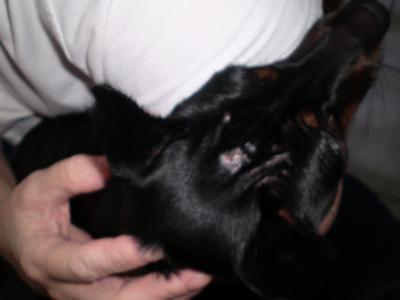
One Example of Demodectic Mange
on Top of Head
In other cases the mites can form something called “generalized mange” which is far more serious. If you notice that your dog’s skin patches have become sore, crusted and oozing, it may be generalized mange. Seek advice from a veterinarian as soon as possible.
Mange, along with many other common dog health problems, preys on unhealthy dogs. If your dog is in poor health, they will be much more susceptible to Demodectic mite (and other mite) problems.
If you haven’t already, check out Dog Health & Wellness and Dog Food & Diet topics for more on how to keep your dog’s immune system in top shape.
How to Treat Dog Mange: Demodectic Mange
Opinions vary on the subject of how to treat dog mange of this type, so it is best to consult a holistic veterinarian who will provide you with both conventional and alternative options.
If you would like to try a holistic and natural treatment first, here are a few recommendations:
- If your dog is in good overall health, try fasting them for five to seven days, following an appropriate dog fasting schedule .
- After the fast, try a natural diet to help rid the dog’s body of any extra buildup of toxins.
- Try supplementing their diet with the herbal Skin & Coat Tonic from Native Remedies. It contains several herbs that have been proven to improve the health of the skin and coat, along with other positive effects such as boosting the immune system, liver, kidney and thyroid functioning. Ingredients include…
- Horsetail – known for its high silica content, which is the main component in all connective body tissues. Positively effects all body tissue along with urinary tract health.
- Dandelion – benefits the liver and digestive system and helps to maintain normal blood pressure.
- Spirulina – contains protein, vitamins and carotenoids and supports energy, the immune system and liver functioning.
- Fucus vesiculosis – concentrated source of minerals, and aids in the production of thyroid hormones which helps to maintain healthy metabolism in all body cells. One of its major effects is to improve overall skin and coat health.
- Kalium sulphate – a salt that is essential for distributing life giving oxygen throughout the body and keeping cell membranes in peak health.
- Try adding a supplement that includes Vitamins E, C and other immune-strengthening supplements to your dog’s diet. Organic Pet Superfood is a good choice with well-rounded ingredients. If you’d rather give your dog her vitamins separately, see the following pages for more information:
- Try rubbing lemon juice on the affected area(s) every day.
How to Treat Dog Mange:
Sarcoptic Mange
Ever heard of scabies?
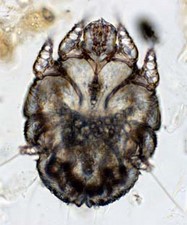
The first time I heard the word scabies was when my roommate in college had an itch that she just couldn’t scratch out! Well… it turned out to be scabies, and I was quite shocked and disgusted, thinking to myself, “I thought she bathed!”
And where do you think she acquired those little friends? You guessed it… from her family pet who was suffering from Sarcoptic mange.
This type of mange is caused by a microscopic mite. The female mite is the culprit, causing the intense itching as she burrows into the skin to lay her eggs.
It only takes three weeks for the life cycle to come full circle, and then it all starts over again…unless you stop them!
Symptoms of Sarcoptic Mange
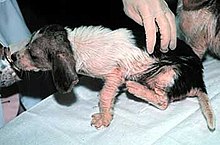
If your dog has contracted Sarcoptic mange, you will observe symptoms similar to that of a flea infestation or severe skin rash or disease.
You will notice your dog digging and biting at itself in a ferocious manner. This will in turn irritate the skin and cause oozing sores, which can then cause a secondary infection.
In the early stages of infestation, common signs of Sarcoptic mange are crusty ear tips, intense itching and loss of hair – mainly on the ears, elbows, legs and face. If the mites are left alone to do serious damage, they will indeed take over the entire body.
If your dog is suffering with any of these symptoms, get them into the vet for an accurate diagnosis.
The symptoms for humans are much less severe. While they will burrow under the skin and cause bothersome itching, they are not able to continue their life cycle on human skin.
How to Treat Dog Mange: Sarcoptic Mange
Since the symptoms of Sarcoptic mange mirror many of the symptoms of dog fleas, dog ticks and other dog skin conditions, it is hard accurately diagnose your dog at home.
It will benefit your dog and the rest of your family if your make an appointment with your veterinarian right away. Hopefully, they will be able to spot the bite marks left over from the microscopic mites and then move forward with treatment.
Frequent medicated baths may help to soothe your dog’s sore skin, along with the application of lemon juice the specific affected areas.
Do you believe in holistic pet care? If so, please tell your friends about us. Thank you for supporting our efforts!
